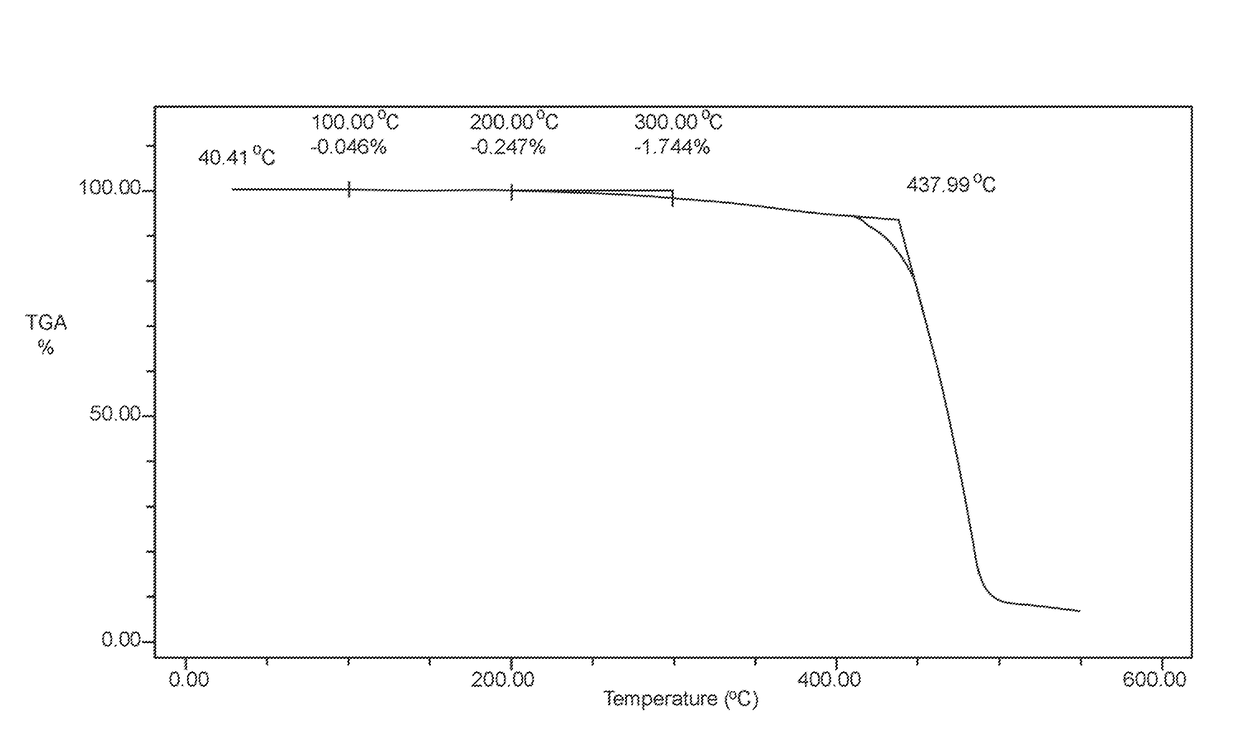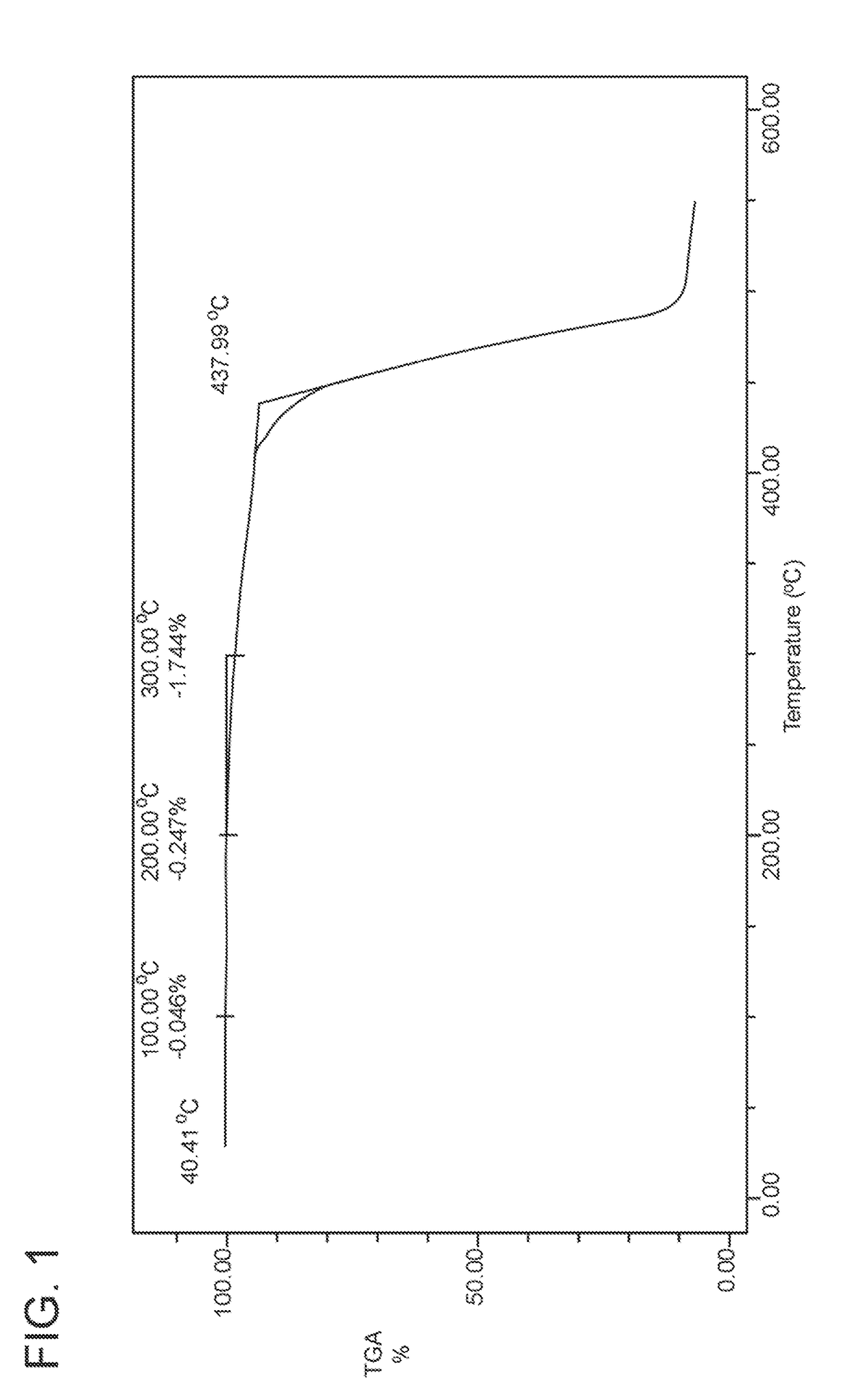Anionic curable compositions
- Summary
- Abstract
- Description
- Claims
- Application Information
AI Technical Summary
Benefits of technology
Problems solved by technology
Method used
Image
Examples
example 1
n of Anionic Curing Catalysts in a BMI-Epoxy Composition
[0205]Several commercially available imidazole type curing agents were evaluated for curing a BMI / epoxy mixture. BMI-689 (Designer Molecules, Inc.), which has the following structure
was used as the base resin with 20% by weight of bisphenol-A diglycidyl ether (DGEBPA) as the epoxy resin. To the BMI / epoxy mix was added 4% by weight of various epoxy-curing catalysts, and the materials were then tested for cure profile using DSC. The mixtures were also tested for room temperature pot-life, determined by the appearance of a dark color that signifies anionic cure of the BMI. The materials were also placed in molds and cured at 175° C. for 1 hour to observe the physical properties of the cured material. The data is shown in Table 2.
TABLE 2Anionic Cure of BMI-689 with DGEBPAPot LifeCUREZOL ®(hrs)DSCDSC PeakCatalystRoom TempOnset (° C.)Max (° C.)Physical Properties1-B2MZ100125Hard, flexible, uniform cureSharp2MA-OK>96171187Non-uniform ...
example 2
n of Cure Catalyst and Percent Epoxy in a BMI-Epoxy Composition
[0207]Maleimide terminated polyimide R1191 (BMI1700; Designer Molecules, Inc., San Diego, Calif.), which has the following structure
was used as a base resin to examine the effects of amine cure and various epoxy concentrations on adhesion to various substrates in a stud pull test. In the initial Control, A, 2% by weight of dicumyl peroxide was dissolved in R1191 to test adhesion using a traditional free-radical cure system. In Control B, 4% CUREZOL® 1-B2MZ was dissolved in R1191 to test the adhesion of the BMI resin using anionic cure without the addition of epoxy. Invention Mix C included 85% by weight R1191 and 15% by weight of ARALDITE® MY-510 epoxy (Huntsman Corporation: The Woodlands, Tex.). Invention Mix D included 75% by weight R1191 25% ARALDITE® MY-510; and Invention Mix E included 65% by weight R1191 and 35% ARALDITE® MY-510. The invention mixes also contained an additional 4% by weight of CUREZOL® 1-B2MZ.
[0208...
example 3
n of Compositions Containing Various Rations of BMI to Epoxy
[0211]Bismaleimide BMI-689 was combined in various ratios with an Epoxy (EPON™-863, (a low viscosity, difunctional epoxy resin produced from bisphenol-F (BPF) and epichlorohydrin; Hexion, Houston, Tex.), the anionic curing catalyst 1-benzyl-2-methylimidazole according to Table 4 below.
TABLE 4Compositions of BMI-EpoxyBMIEpoxyTensileDSC(BMI-689)(EPON ™-863)StrengthExothermsTGAWt % of resinWt % of resin(Psi)(° C.)(° C.)Cure Catalyst4% 1-benzyl-2-methylimidazoleNo.Cured at 185° C.11000 260 psi156N / A290103000 psi15243817837525N / A149.2N / A175.466.633.3N / A145.50N / A193.4355050N / A131.33N / A158.41633.366.3N / A119.27N / A160.8372575N / A114.43N / A157.3280100N / A122.2N / A143.N / A = Not Analyzed
[0212]FIG. 2 shows the DSC cure profile of BMI-689 with 4-wt % 1-benzyl-2-methylimidazole (composition 1). a very low energy broad exotherm is observed at about 156° C. A sample of composition 1 was cured in an oven at 185° C. for one hour. The sample did n...
PUM
| Property | Measurement | Unit |
|---|---|---|
| Temperature | aaaaa | aaaaa |
| Temperature | aaaaa | aaaaa |
| Temperature | aaaaa | aaaaa |
Abstract
Description
Claims
Application Information
 Login to View More
Login to View More - R&D
- Intellectual Property
- Life Sciences
- Materials
- Tech Scout
- Unparalleled Data Quality
- Higher Quality Content
- 60% Fewer Hallucinations
Browse by: Latest US Patents, China's latest patents, Technical Efficacy Thesaurus, Application Domain, Technology Topic, Popular Technical Reports.
© 2025 PatSnap. All rights reserved.Legal|Privacy policy|Modern Slavery Act Transparency Statement|Sitemap|About US| Contact US: help@patsnap.com



